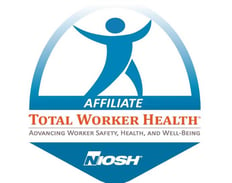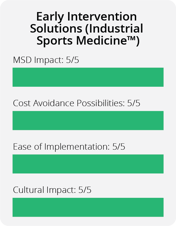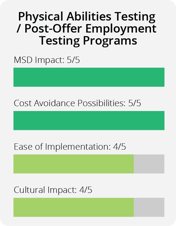Part III - Strategic Injury Prevention Program Planning
Integrated risk assessments identify and prioritize the physical risk factors that cause musculoskeletal injuries and drive workers compensation...
Review of a variety of injury prevention solutions and their impact on workers' compensation claim reduction
We have seen an evolution of musculoskeletal (MSK) care and injury prevention over the past 25 years that has recently been gaining more and more attention. While employers can see the positive effects of well-executed safety, early intervention, and ergonomics programs in their workers’ compensation costs, they also must recognize that costly MSK injuries must be addressed with the proper tools that effectively impact musculoskeletal disorder (MSD) risks both on and off the job.
Not all MSK health solutions are the same. Some solutions can prevent injuries on the job and can have an impact on personal health risks off the job. Others are just different approaches to managing injuries once they occur. Forward-thinking employers are seeking preventative solutions more and more. So which solution is best?
In this article, we will evaluate several common MSK solutions that have become more prevalent within the workplace, looking at which solutions have the best cost avoidance possibilities, ease of implementation, and cultural impact. Specifically, we will examine:
.jpeg?width=223&name=7072D7FF-B07D-40AE-BA13-3F2A673CFD41%20(1).jpeg) In the past 5 years, we’ve seen an explosion in opportunities in the marketplace that all claim they can help reduce MSD costs, but can they work in ANY organization? Does it matter which one you choose? Is one solution better than the other? These are important questions to answer when your organization is looking to address employee health and safety with an eye specifically on MSD prevention and wellness.
In the past 5 years, we’ve seen an explosion in opportunities in the marketplace that all claim they can help reduce MSD costs, but can they work in ANY organization? Does it matter which one you choose? Is one solution better than the other? These are important questions to answer when your organization is looking to address employee health and safety with an eye specifically on MSD prevention and wellness.
Many factors influence organizations’ decisions on which solution to choose. The obvious factors of cost, the potential return on investment (ROI), and efficacy typically inform at least part of the decision. However, other factors have a meaningful effect as well. Perhaps the most impactful aside from cost, ROI, and efficacy is the “agency” issue. Translated, this means “WHO” in the organization needs the solution and “WHICH” cost center are they most closely affiliated with.
As an example, human resources professionals look for effective means of screening new employees, so they are not hiring their next injury. They, along with those within the organization who purchase and administer benefits, also look at solutions to reduce MSD costs that they pay in their group health or self-insured health plans. At times, they work closely with return-to-work professionals that focus on disability cost reductions. Occasionally we see a crossover from these professionals to the environmental health and safety departments (EH&S) who look more closely at reducing occupational hazards that drive MSDs.
 NIOSH and the Centers for Disease Control have strongly promoted a “Total Worker Health” model. These initiatives seek to impact employee health around the clock, recognizing that it doesn’t matter whether an injury or illness occurs on or off the job; the employer still winds up holding the bill. So, if you and your organization agree with this notion, then when comparing “MSK Solutions,” the Total Worker Health philosophy should be a guiding principle. If you can impact an employee’s health by addressing the occupational risks, non-occupational risks, and personal health risks together, the overall impact on the employee’s MSK health is enhanced and the costs associated with managing injury and illness reactively (through the workers’ compensation, health insurance, and/or disability insurance systems) will be reduced or eliminated.
NIOSH and the Centers for Disease Control have strongly promoted a “Total Worker Health” model. These initiatives seek to impact employee health around the clock, recognizing that it doesn’t matter whether an injury or illness occurs on or off the job; the employer still winds up holding the bill. So, if you and your organization agree with this notion, then when comparing “MSK Solutions,” the Total Worker Health philosophy should be a guiding principle. If you can impact an employee’s health by addressing the occupational risks, non-occupational risks, and personal health risks together, the overall impact on the employee’s MSK health is enhanced and the costs associated with managing injury and illness reactively (through the workers’ compensation, health insurance, and/or disability insurance systems) will be reduced or eliminated.
So which solutions crossover well between the “benefits” and “occupational health” domains? We’ve broken down and hopefully demystified the myriad of MSK solutions that are available in the health and productivity industry and defined their scope of impact, relative effectiveness in managing or avoiding costs, ease of implementation (including cost), and cultural impact. This analysis can serve as a guide for you in choosing the appropriate solution based on your organization’s needs.
 Overview: Early Intervention Solutions, sometimes called “Industrial Athlete” or “Industrial Sports MedicineTM” programs, have become increasingly popular with employers as a tool to directly engage with their employees to reduce environmental, ergonomic, and personal health risks that drive MSDs. These programs often include placing an MSK specialist onsite to provide:
Overview: Early Intervention Solutions, sometimes called “Industrial Athlete” or “Industrial Sports MedicineTM” programs, have become increasingly popular with employers as a tool to directly engage with their employees to reduce environmental, ergonomic, and personal health risks that drive MSDs. These programs often include placing an MSK specialist onsite to provide:
These initiatives have an impact across the entire workforce and are a popular choice when an employer seeks to keep an aging and experienced workforce healthy and productive. These programs are occasionally confused with “onsite physical therapy” or “onsite athletic training.” The credentials of the provider placed onsite do not define the program, but rather, are governed by vendor specialty or employer preference.
MSD Impact: Very High
Cost Avoidance Possibilities: Very Significant
Ease of Implementation: VerySimple
Cultural Impact: Very high
 Overview: Physical Abilities Testing (PAT) is commonly applied after a conditional offer of employment has been given to a candidate so that they can prove they are physically able to perform the job. This is called Post-Offer Employment Testing (POET). POET programs are a popular choice for preventing musculoskeletal injuries in industries or situations which have high employee turnover or when injuries in specific jobs tend to occur early in tenure.
Overview: Physical Abilities Testing (PAT) is commonly applied after a conditional offer of employment has been given to a candidate so that they can prove they are physically able to perform the job. This is called Post-Offer Employment Testing (POET). POET programs are a popular choice for preventing musculoskeletal injuries in industries or situations which have high employee turnover or when injuries in specific jobs tend to occur early in tenure.
POET programs should not be confused with traditional medical tests wherein health data is collected, but not used to disqualify candidates. When employers use POET to screen and disqualify candidates who cannot safely perform the physical demands of essential functions, they must do so while adhering to strict compliance measures to avoid triggering exposure from EEOC or ADAAA claims. History has proven time and again, however, that when POET programs are implemented correctly and uniformly, this risk can be completely contained. But be careful. The POET protocols need to EXACTLY match the physical demands of the essential functions. Standardized or “boiler-plate” POET protocols should be avoided at all costs.
Physical Abilities Testing can also be used as a preventative measure post-placement and with incumbent employees. The difference is that instead of testing physical abilities so that you can disqualify or reassign, the test results are used to identify musculoskeletal impairments that can then inform specific activities for the employee in a musculoskeletal wellness program. This allows employees to focus on their area of physical need thereby reducing musculoskeletal risk imposed by personal health issues.
MSD Impact: Very High
Cost Avoidance Possibilities: Very Significant
Ease of Implementation: Initially Complex/Ongoing Simple
Cultural Impact: High
.png?width=176&name=Ergo%20Programs%20Chart%20(1).png) Overview: Ergonomics programs are as diverse and varied as the type of professionals that lay claim to “ergonomics” as a core competence. In its purest form, however, ergonomics, being the science of fitting the work to the worker, involves developing processes to measure risk, identify and test risk abatement solutions, then tying those solutions to business practices. While ergonomics is usually associated with “equipment” (e.g., office chairs, keyboard trays, pallet jacks, robotics/automation, tool design), comprehensive programs incorporate work practice and management controls as well. Employees, the key stakeholders in ergonomics programs, must be part of the program development as well as subjects of training and other behavioral approaches that are important to effective ergonomic management.
Overview: Ergonomics programs are as diverse and varied as the type of professionals that lay claim to “ergonomics” as a core competence. In its purest form, however, ergonomics, being the science of fitting the work to the worker, involves developing processes to measure risk, identify and test risk abatement solutions, then tying those solutions to business practices. While ergonomics is usually associated with “equipment” (e.g., office chairs, keyboard trays, pallet jacks, robotics/automation, tool design), comprehensive programs incorporate work practice and management controls as well. Employees, the key stakeholders in ergonomics programs, must be part of the program development as well as subjects of training and other behavioral approaches that are important to effective ergonomic management.
MSD Impact: Very High
Cost Avoidance Possibilities: Very Significant
Ease of Implementation: Simple
Cultural Impact: Very High
.png?width=176&name=Digital%20MSK%20Solutions%20Chart%20(1).png) Overview: Digital MSK solutions serve as a point of connection for injured employees so that they can access automated content and activities as well as in some cases, virtual/telephonic support for specific conditions. They focus primarily on substituting in-person care for specific diagnoses with apps armed with “artificial intelligence” algorithms supplanting traditional care models.
Overview: Digital MSK solutions serve as a point of connection for injured employees so that they can access automated content and activities as well as in some cases, virtual/telephonic support for specific conditions. They focus primarily on substituting in-person care for specific diagnoses with apps armed with “artificial intelligence” algorithms supplanting traditional care models.
MSD Impact: Very Low (After injury)
Cost Avoidance Possibilities: Low
Ease of Implementation: Very Simple
Cultural Impact: Very Low
Suggested Use: Organizations with exorbitant MSK costs in their group health plans associated with MSK facility and procedures costs. These apps should not be mistaken for MSK injury prevention, but rather less expensive care for injuries once they happen.
.png?width=176&name=Onsite%20Occupational%20Health%20Chart%20(1).png) Overview: Onsite medical services started early on with occupational medicine only. Primary care opportunities supplanted this as a focus, but onsite occupational health services remain an important component of onsite care for some employers. Occupational health and safety models offer additional services specific to occupational health management such as auditory testing, Department of Transportation (DOT) testing when applicable, travel medicine, drug testing, and others. MSK condition management and prevention is becoming more popular in onsite occupational health medicine, this stands to reason considering MSK is the largest cost driver in workers’ compensation for most employers. Reactive measures for MSD management such as onsite physical therapy are sometimes offered, but not always.
Overview: Onsite medical services started early on with occupational medicine only. Primary care opportunities supplanted this as a focus, but onsite occupational health services remain an important component of onsite care for some employers. Occupational health and safety models offer additional services specific to occupational health management such as auditory testing, Department of Transportation (DOT) testing when applicable, travel medicine, drug testing, and others. MSK condition management and prevention is becoming more popular in onsite occupational health medicine, this stands to reason considering MSK is the largest cost driver in workers’ compensation for most employers. Reactive measures for MSD management such as onsite physical therapy are sometimes offered, but not always.
MSD Prevention Impact: Medium
Cost Avoidance Possibilities: Medium
Ease of Implementation: Very Complex
Cultural Impact: High
Given the numerous MSK solutions on the market, it is imperative for an organization to evaluate the specific needs and goals associated with the program to determine which type of solution will best match their needs and desired results.
To aid in the evaluation of these MSK solution types, Briotix Health has created a free reference chart. Click the download button below to save the resource.
Integrated risk assessments identify and prioritize the physical risk factors that cause musculoskeletal injuries and drive workers compensation...
When working with an aging workforce, companies must implement risk reduction strategies to prevent lost-time injuries.
Address cognitive risk in your workplace safety programs! Discover importance of motivational interviewing techniques to promote safe behaviors.
The Briotix Health Blog is your source for new and up-to-date information on industry innovations, in-depth explorations of current topics, and discussions with experts.